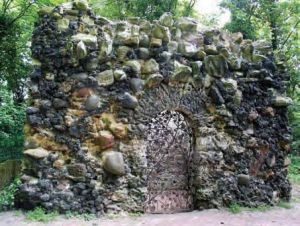|
If you are visiting the Edinburgh area, it is worth going out to the National Trust for Scotland property of Newhailes near Musselburgh. This property was extended and decorated by the Dalrymple family who lived there from 1709 and has seen relatively little alteration since. The policy for the maintenance of the building is to do as much as is necessary but as little as possible. Sir James Dalrymple added the library wing to the house and commissioned much of the interior decoration which features many shells. So many that one child going round the house counted 286 before he gave up. Baskets of tropical seashells feature in the rococo plasterwork of the entrance hall. Gilded scallop-like motifs often feature in the decorative mouldings surround the oil paintings. More originally, the family collected many scallop shells (Pecten maximus) from the shore which were gilded and fastened in columns and rows around the walls. The original gilded door handles feature a spider conch motif with a small gastropod (like Hinia reticulata) which when turned bolts the door. The ground of the house still contain the most complete shell grotto building in Scotland, dating from the 1760s but with the decoration not completed until the 1790s. The exterior of this grotto was made of large boulders and slag, intended to give it the appearance of a volcano. There is evidence of a pit behind the grotto for lighting a fire, both to keep the occupants of the grotto warm and also for the production of atmospheric smoke. The interior was once panelled in wood covered in plaster, in which were embedded shells, fragments of glass and minerals such as agate, quartz and garnet. The shells were collected by the Dalrymples from the nearby beach and as far away as China. Unfortunately the interior of the grotto was burned and vandalised in the 1950s- 60s (before the NTS acquired Newhailes) but photographs remain. As the estate grounds are freely open to the public it would seem unlikely that the interior of the grotto will ever be restored. The house retains much of its original furniture including the contents of the cabinets and chests. Caches of local seashells have been found in these, suggesting that successive generations, just like us today, could not resist bringing them home from the beach. |
Fig 1 Exterior of the shell grotto at Newhailes House, near Musselburgh, Scotland. (photo Rosemary Hill) |
Shells at Newhailes
Issue
11
Page
6

